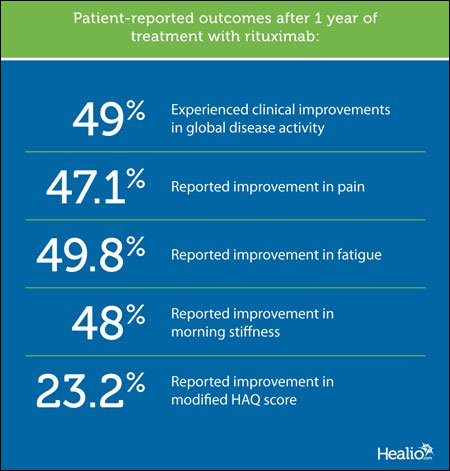Patients With Long-Standing, Refractory RA Had Improvements in Subjective Results 1 Year After Rituximab

Among patients with long-standing refractory rheumatoid arthritis, there were improvements in patient-reported outcomes 1 year after treatment with rituximab, according to a recently published study.
Leslie R. Harrold, MD, MPH, associate professor of medicine and orthopedics at the University of Massachusetts Medical School and senior medical director of pharmacoepidemiology and outcomes research at Corrona, and colleagues aimed to assess how rituximab impacts patient-reported outcomes (PROs) in an observational cohort of 667 patients with active rheumatoid arthritis (RA).
“PRO data are incredibly important,” Harrold told Healio Rheumatology. “The goal of RA therapy is to reduce inflammation, reduce pain and improve function. We need to ask patients how they are doing in order to ensure they get the optimal care. Collection of PROs is essential in order to ensure we are addressing the needs of the patient.”
Eligible participants had previous exposure to one or more tumor necrosis factor (TNF) inhibitor and recent initiation of rituximab therapy. Outcome measures included clinical disease activity index (CDAI), modified health assessment questionnaire (HAQ) and EuroQoL EQ-5D scores, global disease activity, pain and fatigue based on a VAS of zero to 100 and morning stiffness. Baseline data showed that across a number of measures, 54% of the cohort reported high disease activity.
Results at 1 year indicated 49% of patients experienced clinical improvements in global disease activity. Other findings from 1 year showed 47.1% reported improvement in pain, a 49.8% reported improvement in fatigue and 23.2% reported improvement in modified HAQ score.
“Our results demonstrated that treatment with rituximab can improve health-related quality of life,” Harrold said, highlighting the improvements across assessment measures and parameters. “This is particularly notable since the cohort consisted of the harder-to-treat patients, meaning those with long-standing disease with prior use of other biologic agents.”
Other results indicated morning stiffness improved in 48% of the cohort, while 19% to 32% experienced better EuroQoL EQ-5D scores. Improvements in EQ-5D were reported across all domains, including walking, self-care, usual activities, pain or discomfort, and anxiety or depression.

The 1-year improvement in CDAI score was 8. The CDAI low disease activity (LDA) remission rate at 1 year was 30.4%. Patients who had received treatment with one prior TNF inhibitor were more likely to achieve CDAI LDA remission than those who had received two or more previous TNF inhibitors.
“These data help us to understand what patients experience,” Harrold said. “As patients and providers discuss potential medications for the management of RA, providers should be communicating about these PROs to aid in the decision-making process. Patients want to know what to expect for outcomes. What is noteworthy in this study was that the patients initiating rituximab had long-standing and refractory disease and still experienced improvements in their PROs after 1 year of treatment.” – by Rob Volansky and Will Offit
Disclosure: Harrold reports she is an employee of the University of Massachusetts Medical School and is a consultant for Bristol-Myers Squibb.
